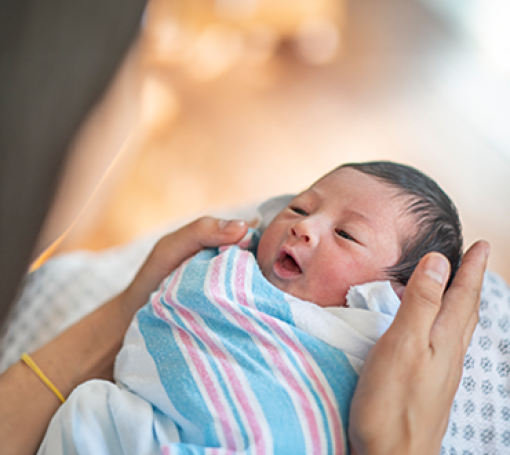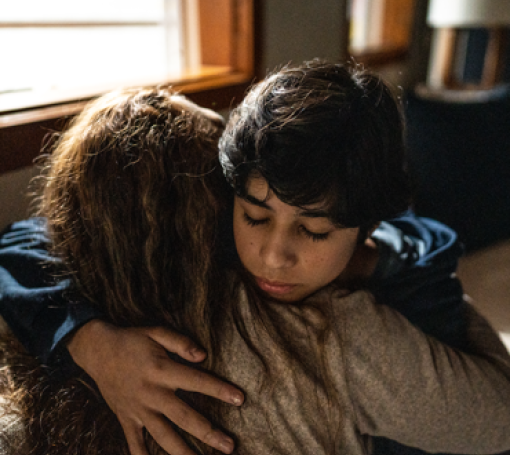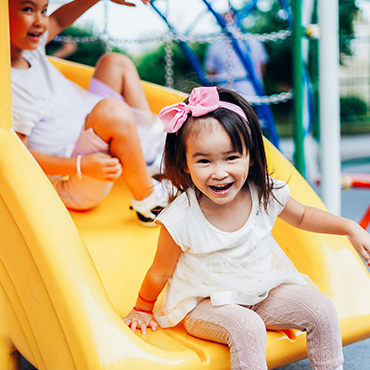Summer brings long days, warm weather, and endless opportunities for fun—but it also comes with important safety considerations for children of all ages. As families spend more time outdoors, in the water, on the road, and on digital devices, staying informed about seasonal risks can help ensure a safe and memorable summer. That’s where the “5 S’s of Summer Safety” come in: Sun, Swim, Streets, Slips, and Screens. These five areas highlight common hazards and offer age-specific guidance to help protect infants, children, and adolescents throughout the season.
Sun
Summer means more time spent outdoors and in the sunshine. It is important to protect skin from UV exposure, which can cause sunburn and an increased risk of skin cancer.
- Infants: Physical barriers such as hats and UPF (ultraviolet protection factor) clothing are first line protection against prolonged and high intensity sun exposure. For children under 6 months old, application of small quantities of mineral based (zinc oxide and/or titanium dioxide) sunscreen to surfaces which cannot be covered is recommended (such as nose, hands).
- Children/Adolescents: Sun-protective clothing continues to be the first line of defense against sun exposure, complimented by sunscreen with an SPF rating of 30+.
Swim
Drowning and injury from water-based sports increase during warm summer months. Families can work to decrease risks by teaching their children about water safety and following safety recommendations when enjoying the water.
- Infants: The AAP advises babies to be supervised any time they are near water. Additionally, younger infants should be monitored for signs of hypothermia if in the water for extended periods of time. Infants should never be left unattended in water, including shallow bodies of water, pools, or bathtubs.
- Children: Caregivers should consider swimming lessons and safety courses for children over 1 year of age. Children should always be kept within an arm’s length of an adult when near water. An adult should be specifically designated to supervise children near any body of water, including lakes, ponds, and pools. This person should remain free from distractions such as cell phones, television, and alcohol. U.S. Coast Guard approved life jackets should be worn by children during all water-based activities.
- Adolescents: Adolescents should be educated on risks of drowning and injury with water-based sports. U.S. Coast Guard approved life jackets should be worn during use of watercraft and when in open-water settings.
Streets
More time spent outdoors and traveling means more time around motorized vehicles. For car seat inspection assistance, see the following link: Find a Car Seat Inspection Station in Washington - WA Child Passenger Safety
- Infants: Infants in strollers should always be securely strapped in, and an adult should always keep a hand on the stroller. Families should work to stay on sidewalks when able and use designated crosswalks to cross traffic. All infants under the age of 2 years old should be secured in rear-facing car seats when traveling in a vehicle.
- Children: Children should be taught street safety, including how to recognize the sound of approaching vehicles and the importance of crossing streets with adult supervision whenever possible. They should use proper techniques like looking both ways and avoiding distractions when near traffic. All children using bicycles or engaged in recreational sports involving wheels should be wearing helmets. All children over 2 years of age should travel in a properly fitted car seat or booster seat.
- Adolescents: Teens should be educated on safety both around cars and while riding in them, including always wearing a seatbelt and encouraging drivers to minimize distractions. Consider creating a Parent-Teen Driving Agreement. Adolescents should continue to wear properly fitting helmets when on bicycles, scooters, or recreational vehicles.
Slips
Summertime means adventuring. Children and families should be aware of the risks of falls and related injuries during popular summertime activities.
- Infants: Young children should be properly restrained and secured in all carriers. Infants, even if immobile, should not be left unattended near stairs, railings, or cliffs.
- Children: Children are curious and active. Many children each year seek care in our local emergency departments after falling from open windows, recreational vehicles, and outdoor equipment. No child should be left unattended near open windows (even when screens are present), within motorized vehicles of any type, or near any motorized equipment such as lawn mowers, tractors, etc.
- Adolescents: Risks of falls from hiking and rock-climbing increase during warmer months. Adolescents interested in outdoor adventures should be educated on general safety and rescue techniques. Adolescents should be encouraged to participate in group activities of more than 2-3 people outdoors.
Screens
With more time spent out of school and traveling, families often lean on screen-based programming to teach their children and occupy their time.
- Infants: Infants under 2 years of age are not advised to have screen time.
- Children: Children under 5 years of age should be limited to no more than 1 hour of screen time per day. Time spent should be monitored with use in shared spaces only and restricted to appropriate age-based content.
- Adolescents: Adolescents should be educated on healthy use of screens, internet, and social media. Content restrictions should continue to prevent the use of inappropriately rated content. Adolescents should be discouraged from engaging with strangers on social media or video game platforms.
Keep Reading
View All Posts
Helping Kids Breathe Easier
By checking asthma control at every well care visit, we can identify changes early and make sure each child has the support they need to breathe comfortably and stay active.

Protecting Your Newborn from Hepatitis B
Learn why the birth dose of the hepatitis B vaccine matters for every baby.

Community Support for Youth Suicide Prevention
Learn how families can recognize warning signs, foster open communication, and create a supportive environment to help prevent suicide among teens.

